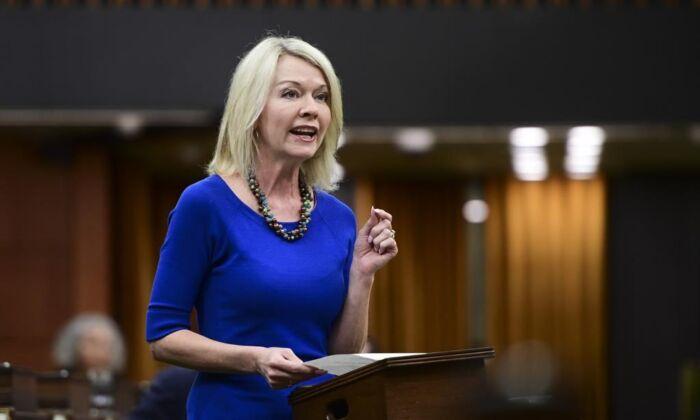The newly elected interim leader of the Conservative Party, Candice Bergen, used her first opportunity at the helm during question period to raise the issue of the convoy protest and ask how the government is planning to help resolve it.
“The protesters and, to be more accurate, the trucks have been parked outside in Ottawa for almost a week now, and instead of presenting a plan, which is what I think a lot of people in this country would like to see, to work with the people who are out there to help them feel they have been listened to, the prime minister is threatening Canadians with more vaccine mandates for interprovincial trade and travel,” Bergen said on Feb. 3.
“Can the prime minister please tell Canadians what role he feels the government can play and what it can do to help solve the impasse?”
With Prime Minister Justin Trudeau not in attendance, Deputy Prime Minister Chrystia Freeland responded to Bergen.
“When it comes to the ongoing protests, all of our government and I clearly condemn the desecration of national monuments and the display of hateful symbols that this protest has tolerated,” replied Freeland.
“Maybe all the horns affected her hearing, because I do not know if she heard my question, so I am going to ask it again: Where is the olive branch?” Bergen fired back.
“We are talking about an impasse on Parliament Hill. We need to have some solutions,” she said.
Freeland then doubled down on portraying the protest as being racist, with Bergen countering that the allegation was “classic gaslighting,” defined as a manipulation technique involving the repetitious feeding of false information.
On Feb. 4, Bergen issued a press release calling the truck drivers to “remain peaceful. Call out and denounce any acts of hate, racism, intolerance or violence.”
“Canadians and Conservatives have heard you loud and clear. Regardless of political stripe, we all want an end to the demonstrations, and we all want an end to the restrictions.”
CTV News reported Thursday that it had obtained one of Bergen’s internal emails dated Jan. 31, which said Bergen proposed using the protest against Justin Trudeau.
Bergen became interim leader of the party on Feb. 2 after 73 out of 118 Conservative MPs voted to remove former leader Erin O’Toole.
O’Toole took a cautious approach toward the Freedom Convoy. The vaccine mandate that came into effect for cross-border truckers on Jan. 22 was the spark that ignited the cross-Canada protest movement.
In contrast, Bergen and vocal Conservative MPs like Pierre Poilievre have taken a non-equivocal stance in support of the protesters, who have been demonstrating in Ottawa since Jan. 30.
Abacus Data Survey
Meanwhile, David Coletto, the CEO of the Abacus Data polling firm, said there appear to be no real political winners regarding the protests upon the release of a survey of Canadians’ views on the matter on Feb.3.
“Erin O’Toole may have lost his job because of the division over the convoy within his party, while Prime Minister Trudeau finds widespread dissatisfaction with his handling of the issue,” Coletto wrote.
The nationwide survey of 1,410 people showed that 32 percent of respondents say they “have a lot in common” with how the protesters see things, while 68 percent say they have “very little in common.”
The survey also showed support for the protest among voters from different political parties.
Voters from the People’s Party of Canada (82 percent), the Greens (57 percent), and the Conservatives (46 percent) had the largest proportions of people saying they “have a lot in common” with the protesters. Meanwhile voters from the Bloc (81 percent), the NDP (77 percent), and the Liberals (75 percent) “have very little in common.”
“I think these numbers reflect a combination of things–clearly a good number of people share frustration with the seemingly endless pandemic and the measures that are making life uncomfortable, and some find themselves aligned with this part of the protestors’ message,” wrote Abacus chairman Bruce Anderson.
“At the same time, a substantial majority don’t feel they can identify with everything about the protest and many were turned off by the methods and messages that they observed from the convoy, once it arrived in Ottawa.”





